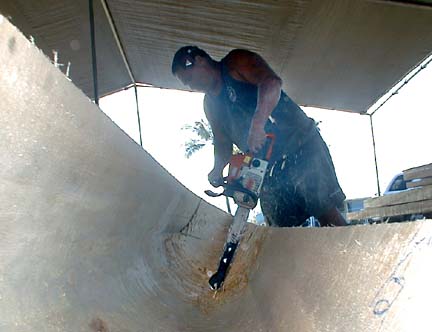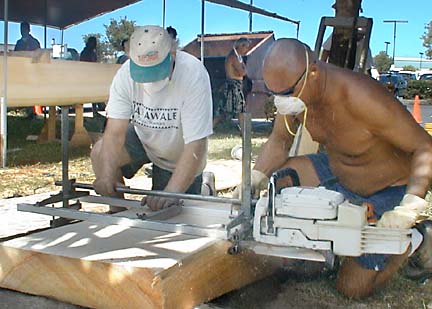

|
Sharing a tradition
A father and son display their
craft of building canoes for races
HILO >> The Big Island's large, non-native albizzia trees are usually disdained as "junk" because of their soft wood and brittle branches.
But albizzia logs are now serving as a source of pride as a streetside demonstration project turns them into Hawaiian canoes in preparation for the 2004 Hilo World Sprints set for next Monday to Aug. 15 on Hilo Bay.
The event, conducted by the International Va'a Federation, will bring together 1,800 paddlers from 20 countries and regions, as well as some 3,000 friends and relatives.
The races will consist of one-person canoes, six-person canoes and double-hulled events with two of the larger canoes lashed together. By regulation of the federation, all of those canoes are made of fiberglass.
So retired Department of Education specialist Ray Bumatay, 64, is closer to traditional materials as he and friends use the albizzia logs to demonstrate canoe making at a spot fronting Borders Bookstore at the side of Hilo's busy Kalanianaole Avenue.
Bumatay has made and repaired canoes for 30 years, five of them koa, 15 albizzia. "I love working with koa, but albizzia is a good teaching tool," he said.

|
While Bumatay and three main assistants help with two 26-foot hulls, high school students from Ka Ana La'ahana Charter School are shaping two 13-foot hulls under his guidance.
"My grandfather was a canoe builder. He planted the seed. My mom nurtured the seed," Bumatay said.
"My mom would draw pictures (of canoes) in the sand," he said. "What I have learned never came from books. The books never had enough information for me."
The tradition continues with Bumatay's son Doug, 33, who said he has been helping his father since he was 3.
"I started off passing tools, sweeping dust, getting in his way."
Like his father, his knowledge comes from hands-on experience. "It's basically from extensive trial and error. Once in a while, I talk story with other woodworkers," Doug said.
Although making canoes has not been secretive, the process is usually done in someone's back yard, away from the public. Bumatay's demonstration is probably the first one ever done on the edge of a major urban street with folding chairs and a tarp set up for shade for people who want to watch.
Bumatay expects to assemble the two larger hulls and two smaller hulls into double-hulled canoes in time for a blessing for both albizzia and fiberglass canoes on Sunday. Only the fiberglass canoes will participate in the races.
Canoe organizers have had 10 of the one-person and 10 of the six-person canoes constructed, said race assistant Gail Makuakane-Lundin.
The World Sprints officially start next Monday with practice events, and the first of 349 real races starts Aug. 11. The sprints involve 349 races grouped in 44 events, further divided into 500-, 1,000- and 1,500-meter distances.
For a competition guided by an organization originally named the International Polynesian Canoe Federation in 1981 and now named Va'a for the Tahitian word for canoe, it's not surprising that competitors come from all over the Pacific. But additional competitors will come from Brazil, France and Italy.
Although the federation was organized by representatives from Hawaii, Tahiti and California, the event in Hilo is the first time Hawaii has hosted the competition since Honolulu served in that role in 1988.
|